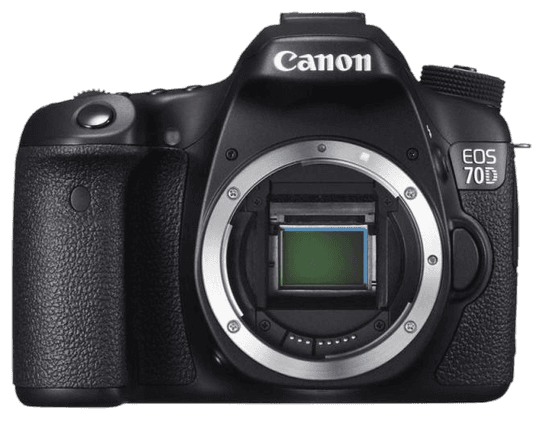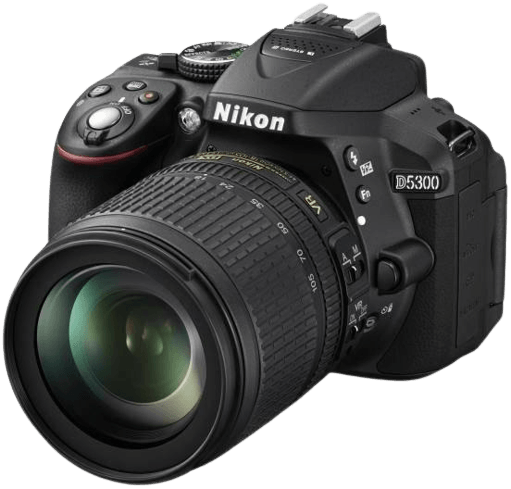Canon EOS 70D vs Nikon D5300 Comparison
Canon EOS 70D

Nikon D5300

The Canon EOS 70D outperforms the Nikon D5300 with a score of 60/100 compared to 57/100. Both cameras are DSLR models released in 2013, with the 70D announced on 07/02/2013 and the D5300 on 10/17/2013. They share similar specifications, but the 70D has advantages that contribute to its higher score.
The Canon EOS 70D is larger (139 x 104 x 79mm) and heavier (755g / 1.66lbs) than the Nikon D5300 (125 x 98 x 76mm and 480g / 1.06lbs). This might make the 70D more robust and better suited for professional use. However, the Nikon D5300’s smaller size and lighter weight could be preferable for casual photography and travel.
The Canon EOS 70D’s launch price was $1,199, while the Nikon D5300 was more affordable at $800. Despite the higher price, the 70D’s superior performance justifies the cost for those seeking a more advanced camera. On the other hand, the Nikon D5300 offers good value for those on a tighter budget.
Considering the specifications and performance, the Canon EOS 70D is the better choice for professional use, while the Nikon D5300 is a more budget-friendly option for casual photography.
Canon EOS 70D vs Nikon D5300 Overview and Optics
The Nikon D5300 takes the lead in optics with a score of 65/100, compared to the Canon EOS 70D’s score of 58/100. Both cameras share several common specifications, such as the CMOS sensor type, APS-C sensor size, and the lack of image stabilization. However, there are distinct differences that set them apart in terms of optical performance.
The Nikon D5300 boasts a higher megapixel count at 24.2, compared to the Canon EOS 70D’s 20.2 megapixels. This difference allows the Nikon D5300 to capture more detailed and sharper images. Additionally, the Nikon D5300 has a superior DXOMARK sensor score of 83, compared to the Canon EOS 70D’s score of 68. This indicates that the Nikon D5300 has better overall image quality, dynamic range, and low-light performance.
On the other hand, the Canon EOS 70D has a faster shooting speed of 7 frames per second, compared to the Nikon D5300’s 5 frames per second. This advantage makes the Canon EOS 70D better suited for capturing fast-moving subjects or action photography. Furthermore, the Canon EOS 70D features a Digic 5+ processor, while the Nikon D5300 has an Expeed 4 processor. However, this difference in processors does not significantly impact the overall optics performance.
Both cameras are equipped with different lens mounts – the Canon EOS 70D uses the Canon EF-S mount, while the Nikon D5300 utilizes the Nikon F DX mount. This difference allows users to choose from a wide range of compatible lenses, depending on their specific needs and preferences.
Taking these factors into account, the Nikon D5300 emerges as the superior camera in terms of optics, due to its higher megapixel count and better sensor performance. However, the Canon EOS 70D’s faster shooting speed may be an advantage for some users, depending on their photography requirements.
Canon EOS 70D vs Nikon D5300 Video Performance
The Nikon D5300 outperforms the Canon EOS 70D in the video department, with a video score of 70/100 as opposed to the 70D’s 43/100. Both cameras share some common specifications, such as Full HD video resolution and max video dimensions of 1920 x 1080. However, the differences in their video capabilities become apparent when examining their frame rates and additional features.
The Nikon D5300’s superiority in video performance is evident in its higher max video frame rate of 60fps, compared to the Canon EOS 70D’s 30fps. This higher frame rate allows for smoother video playback and improved slow-motion footage. In addition, the D5300 has built-in time-lapse functionality, which the 70D lacks. This feature enables users to capture stunning time-lapse videos without needing additional equipment or software.
While the Canon EOS 70D falls short in comparison to the Nikon D5300 in terms of video capabilities, it still offers respectable performance with its Full HD resolution and 1920 x 1080 video dimensions. However, the lower frame rate and lack of time-lapse functionality place it at a disadvantage compared to the D5300.
Taking these factors into account, the Nikon D5300 stands out as the better choice for video enthusiasts, offering smoother playback, better slow-motion capabilities, and the added bonus of built-in time-lapse functionality. On the other hand, the Canon EOS 70D remains a solid option for those who prioritize other features and are satisfied with its video performance despite its limitations.
Canon EOS 70D vs Nikon D5300 Features and Benefits
The Canon EOS 70D outperforms the Nikon D5300 with a feature score of 70 out of 100, compared to the Nikon’s score of 46. Both cameras share several specifications, such as a flip screen, Wi-Fi connectivity, and no Bluetooth support. However, the Canon EOS 70D proves to be the better camera in terms of features.
The Canon EOS 70D boasts a touchscreen, which the Nikon D5300 lacks. This feature allows users to navigate menus and settings more efficiently. Additionally, the Canon’s screen resolution is slightly higher at 1,040,000 dots, compared to the Nikon’s 1,037,000 dots. This difference results in a marginally clearer image display on the Canon EOS 70D.
On the other hand, the Nikon D5300 has a larger screen size of 3.2 inches, compared to the Canon EOS 70D’s 3-inch screen. This size difference provides a slightly more comfortable viewing experience for the Nikon users. Moreover, the Nikon D5300 features GPS functionality, which the Canon EOS 70D does not have. This feature allows Nikon users to geotag their photos, which can be useful for organizing and documenting travel photography.
Despite these advantages, the Nikon D5300’s feature score remains lower than the Canon EOS 70D. The Canon’s touchscreen and higher screen resolution contribute significantly to its superior feature score. The Nikon D5300’s larger screen and GPS functionality do not outweigh the benefits of the Canon EOS 70D’s features. Therefore, the Canon EOS 70D is the better camera in terms of features.
Canon EOS 70D vs Nikon D5300 Storage and Battery
The Canon EOS 70D wins in the storage and battery category, scoring 37/100 compared to the Nikon D5300’s 29/100. Both cameras have one memory card slot and accept SD, SDHC, and SDXC cards. Neither camera supports USB charging.
The EOS 70D has a longer battery life, allowing for 920 shots, while the D5300 can only take 600 shots per charge. This difference makes the 70D a better option for extended shooting sessions. The 70D uses an LP-E6 battery, whereas the D5300 uses an EN-EL14a battery.
Despite the lower score, the Nikon D5300 shares the same storage capabilities as the Canon EOS 70D. The main disadvantage of the D5300 is its shorter battery life. When considering storage and battery, the Canon EOS 70D is the superior choice due to its longer battery life, providing more shots per charge.
Canon EOS 70D vs Nikon D5300 – Our Verdict
Are you still undecided about which camera is right for you? Have a look at these popular comparisons that feature the Canon EOS 70D or the Nikon D5300:

